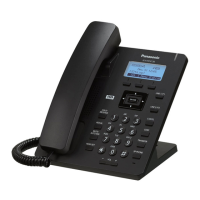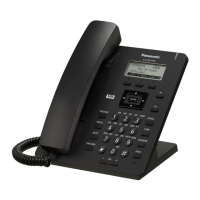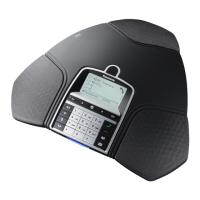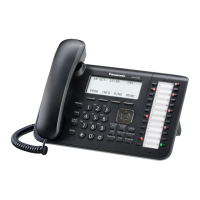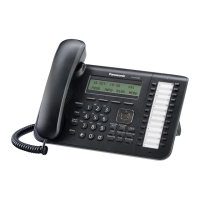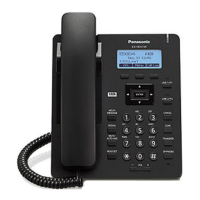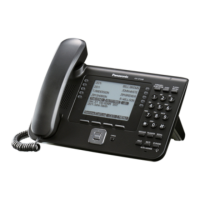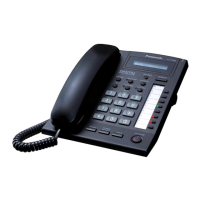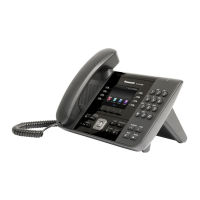Do you have a question about the Panasonic KX-HGT100 and is the answer not in the manual?
How to access the phone's web-based configuration interface via browser.
Details on the username and password required for initial access.
Displays model, operating bank, IPL, and firmware versions.
Indicates if a profile is set and if registration is possible.
Shows MAC address, connection status, and mode.
Information on the default static IP, subnet mask, and gateway.
Choosing between Static IP and DHCP for network connectivity.
Important note about re-connecting the browser when using DHCP.
Input fields for IP address, subnet mask, and default gateway.
Option to add DNS server addresses for network resolution.
Screen for enabling and saving DHCP settings.
Procedure to check the IP address assigned by DHCP.
Ensuring the connected PC is on the same network segment for DHCP.
Instructions for setting a new username and password.
Configuring the idle timeout for the HTTP port.
Entering SIP extension details, including telephone number and SIP ID.
Configuring SIP proxy, registrar, and domain information.
Inputting SIP number, account, and password for registration.
Setting SIP proxy, registrar, and domain using IP or DNS.
Setting voice traffic port range and prioritizing codecs like G711, G729.
Configuring DTMF transmission and the SIP UDP control port.
Managing Caller ID features and Diffserv (ToS) for network traffic.
Saving current settings to a file for backup.
Restoring settings from a saved configuration file.
Using configuration files to create profile templates for easy deployment.
Uploading new firmware files via the web interface.
Instructions to power cycle the unit after firmware update.
Configuring the speed and duplex settings for the LAN/PC port.
Enabling auto-negotiation for speed and duplex modes.
Description of keys like PROGRAM, OK, NAVI, SP-Phone, MUTE, REDIAL.
Notes that SP-Phone, Hold, and Message keys feature LEDs.
Step-by-step guide to saving a speed dial number.
Method to retrieve and dial a speed dial number.
Procedure for setting the current year, month, day, and time.
Setting options for showing or hiding caller ID (CLIR).
Steps to change the contrast of the phone's LCD display.
Choosing from different ringer tone styles for incoming calls.
Setting the volume level for the phone's ringer.
Setting options for hold music playback.
Adjusting the volume of keypress tones.
Choosing between AM/PM and 24-hour time formats.
Selecting the user interface language for the phone.
Choosing between static IP or DHCP for network configuration.
Entering default gateway, subnet mask, and IP address.
Accessing and displaying network configuration details.
Showing current operational status and network parameters.
Steps to restore the unit to its original factory default settings.
Instructions to revert to a previous firmware version.
How to re-open the HTTP port after initial setup or idle timeout.
How to access the phone's web-based configuration interface via browser.
Details on the username and password required for initial access.
Displays model, operating bank, IPL, and firmware versions.
Indicates if a profile is set and if registration is possible.
Shows MAC address, connection status, and mode.
Information on the default static IP, subnet mask, and gateway.
Choosing between Static IP and DHCP for network connectivity.
Important note about re-connecting the browser when using DHCP.
Input fields for IP address, subnet mask, and default gateway.
Option to add DNS server addresses for network resolution.
Screen for enabling and saving DHCP settings.
Procedure to check the IP address assigned by DHCP.
Ensuring the connected PC is on the same network segment for DHCP.
Instructions for setting a new username and password.
Configuring the idle timeout for the HTTP port.
Entering SIP extension details, including telephone number and SIP ID.
Configuring SIP proxy, registrar, and domain information.
Inputting SIP number, account, and password for registration.
Setting SIP proxy, registrar, and domain using IP or DNS.
Setting voice traffic port range and prioritizing codecs like G711, G729.
Configuring DTMF transmission and the SIP UDP control port.
Managing Caller ID features and Diffserv (ToS) for network traffic.
Saving current settings to a file for backup.
Restoring settings from a saved configuration file.
Using configuration files to create profile templates for easy deployment.
Uploading new firmware files via the web interface.
Instructions to power cycle the unit after firmware update.
Configuring the speed and duplex settings for the LAN/PC port.
Enabling auto-negotiation for speed and duplex modes.
Description of keys like PROGRAM, OK, NAVI, SP-Phone, MUTE, REDIAL.
Notes that SP-Phone, Hold, and Message keys feature LEDs.
Step-by-step guide to saving a speed dial number.
Method to retrieve and dial a speed dial number.
Procedure for setting the current year, month, day, and time.
Setting options for showing or hiding caller ID (CLIR).
Steps to change the contrast of the phone's LCD display.
Choosing from different ringer tone styles for incoming calls.
Setting the volume level for the phone's ringer.
Setting options for hold music playback.
Adjusting the volume of keypress tones.
Choosing between AM/PM and 24-hour time formats.
Selecting the user interface language for the phone.
Choosing between static IP or DHCP for network configuration.
Entering default gateway, subnet mask, and IP address.
Accessing and displaying network configuration details.
Showing current operational status and network parameters.
Steps to restore the unit to its original factory default settings.
Instructions to revert to a previous firmware version.
How to re-open the HTTP port after initial setup or idle timeout.
| Type | IP Phone |
|---|---|
| Protocols | SIP |
| PoE Support | Yes |
| Display | LCD |
| Bluetooth | No |
| Wi-Fi | No |
| Headset Jack | Yes |
| Speakerphone | Yes |
| Power Supply | AC Adapter or PoE |
| Handset | Yes |
| Wall Mountable | Yes |
| Voice Codecs | G.711, G.729 |
| Call Features | Call Hold, Call Transfer, Call Waiting, Caller ID |
